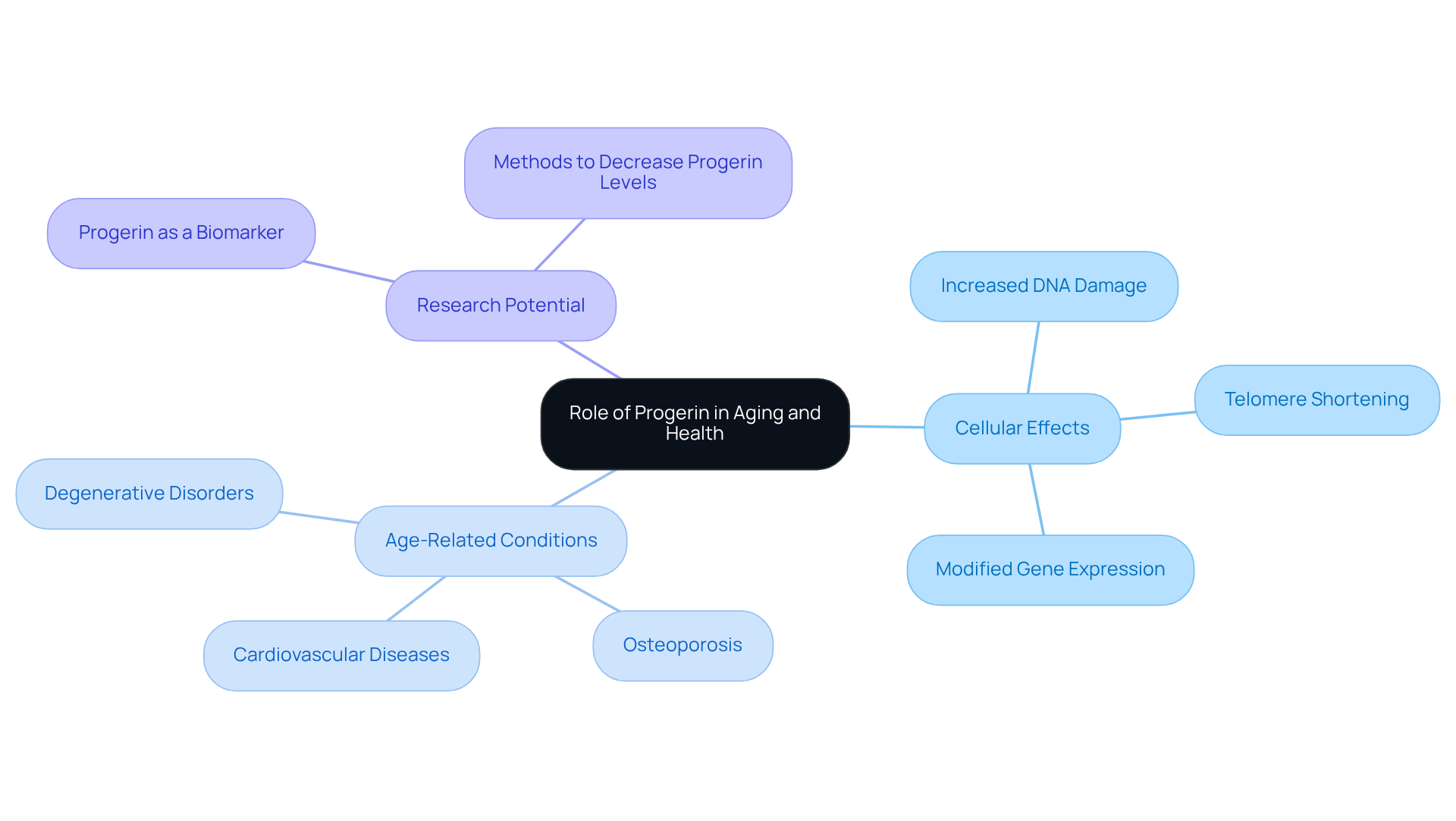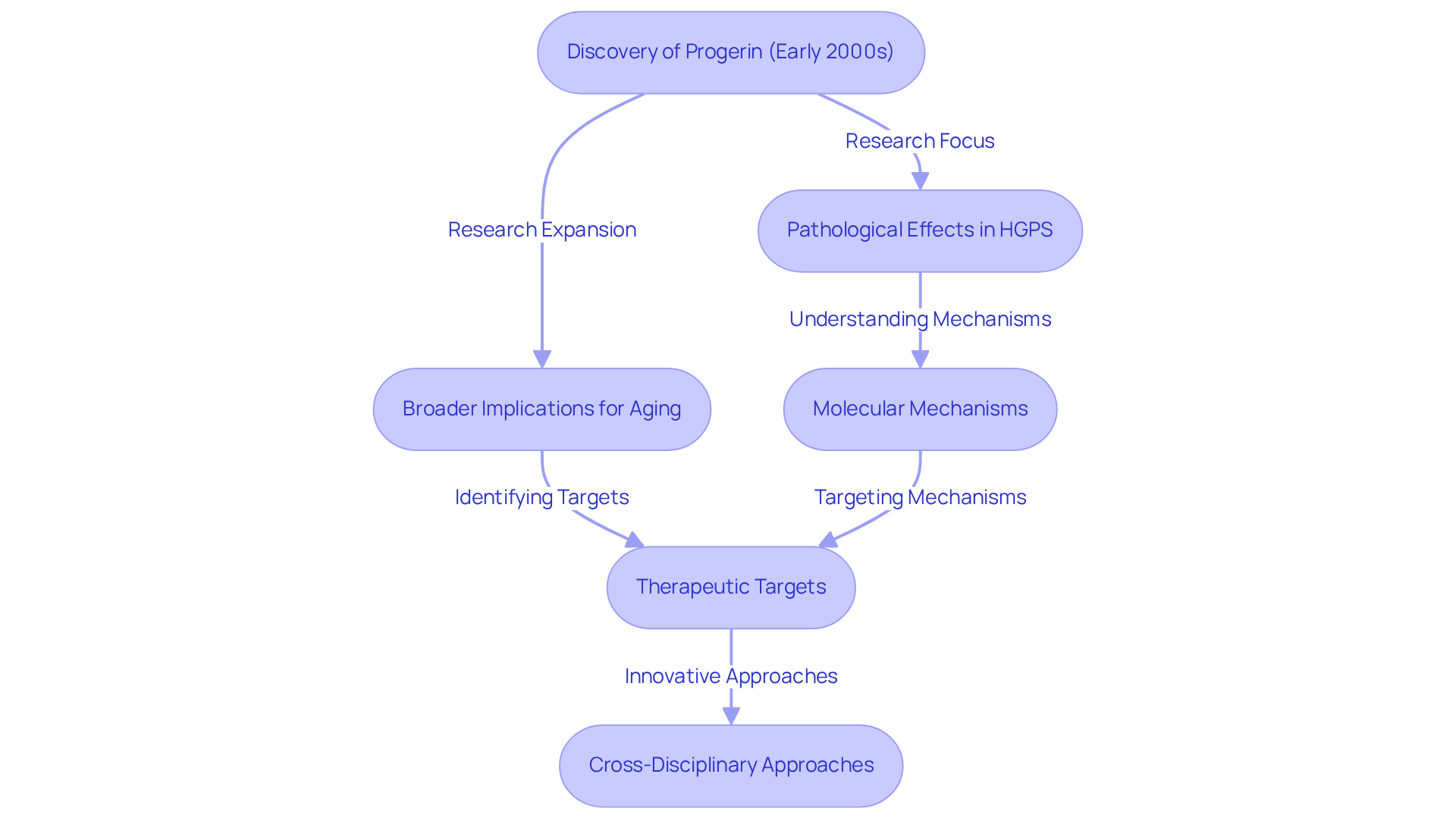Understanding Progerin Protein: Its Role in Aging and Health
Overview
The progerin protein, a truncated form of lamin A, plays a critical role in aging and health. It disrupts nuclear envelope integrity, leading to cellular dysfunction and age-related disorders. Furthermore, the accumulation of progerin is linked to increased DNA damage, telomere shortening, and various health issues. This highlights its potential as a biomarker for biological senescence and a target for therapeutic interventions. Understanding the implications of progerin can provide valuable insights into aging and open avenues for future research and treatment options.
Introduction
The progerin protein, a truncated form of lamin A, has emerged as a pivotal player in the biological landscape of aging and health. Its accumulation within the cell nucleus disrupts normal cellular functions, leading to a cascade of age-related disorders, including Hutchinson-Gilford Progeria Syndrome.
As research unveils the intricate mechanisms by which progerin influences cellular senescence and overall health, the question arises: could targeting progerin levels be the key to unlocking healthier aging and combating age-associated diseases?
This inquiry not only highlights the importance of understanding progerin’s role but also opens avenues for potential therapeutic strategies that may enhance the quality of life as we age.
Define Progerin Protein and Its Biological Function
The progerin protein, which is a truncated variant of the lamin A protein, plays a crucial role in maintaining the structural integrity of the nuclear envelope in cells. This protein arises from a mutation in the LMNA gene, specifically a single nucleotide change that results in abnormal splicing. Consequently, the protein lacks the essential cleavage site required for post-translational modifications, leading to its accumulation within the cell nucleus. This buildup disrupts standard nuclear structure and function, significantly contributing to cellular deterioration and various age-associated disorders, particularly Hutchinson-Gilford Progeria Syndrome (HGPS).
Recent research has highlighted the prevalence of LMNA gene mutations in the population, with progeroid levels potentially serving as indicators for senescence and related health concerns. For instance, studies indicate that the expression of a specific protein correlates with systemic inflammation and vascular issues, especially among individuals with diabetes. Moreover, this protein’s biological role extends beyond structural functions; it also regulates processes that govern the passage of time. The disruption of nuclear envelope integrity by the progerin protein can lead to increased oxidative stress and impaired cell function, further accelerating the aging process.
Innovative interdisciplinary methods, such as those explored in Dr. Joseph Dituri’s underwater experiment, provide valuable insights into the biology of aging. His study has revealed specific mechanisms through which environmental factors influence cellular deterioration, underscoring the potential for treatments targeting the progerin protein levels. Case studies demonstrate that therapies like lonafarnib can significantly reduce the accumulation of harmful proteins and improve health outcomes in individuals with HGPS. Additionally, the dietary practices observed in cultures known for their longevity, such as the Hunza people, emphasize a diet rich in whole foods—including fruits, vegetables, and healthy fats—that may be essential for maintaining health and wellness. These findings underscore the importance of understanding the progerin protein’s role in cellular aging and its potential as a therapeutic target for age-related diseases.

Explore the Role of Progerin in Aging and Health
The progerin protein plays a significant role in the aging process, primarily through its involvement in senescence—a condition where cells lose their ability to divide and function effectively. The build-up of the progerin protein is linked to various cell dysfunctions, including:
- Increased DNA damage
- Telomere shortening
- Modified gene expression
These cellular changes contribute to the development of age-related conditions such as cardiovascular diseases, osteoporosis, and other degenerative disorders.
Studies indicate that the progerin protein levels increase with age in the general population, suggesting that it could serve as a biomarker for biological senescence. Furthermore, research investigating methods to decrease levels of the progerin protein has shown potential in mitigating certain negative impacts linked to aging. This highlights the importance of focusing on the progerin protein in the pursuit of more vibrant later years.
What steps can we take to further explore this promising area of research?

Trace the Discovery and Evolution of Progerin Research
The early 2000s marked a significant milestone in scientific research with the discovery of the progerin protein, which is linked to the LMNA gene mutation responsible for Hutchinson-Gilford Progeria Syndrome (HGPS). Initial inquiries concentrated on the pathological effects of progerin protein in individuals with HGPS, underscoring its critical role in accelerated aging. As research progressed, the focus broadened to examine the progerin protein’s presence in the general population and its potential implications for natural aging processes.
Remarkable advancements have been made in elucidating the molecular mechanisms by which the progerin protein disrupts cellular function. This progress paves the way for identifying therapeutic targets for age-related diseases. Recent studies have delved deeper into the interactions involving the progerin protein and other aging-related proteins, significantly enriching the field of longevity research.
Importantly, approximately 400 children worldwide are diagnosed with progeria, emphasizing the urgent need for continued exploration in this area. Since 2002, the annual number of scientific articles published on progerin protein and progeria has surged, reflecting a growing interest and investment in understanding this condition and its broader implications for longevity.
Insights gained from innovative cross-disciplinary approaches, such as Dr. Joseph Dituri’s underwater studies, suggest that probing the biological processes of aging could lead to groundbreaking advancements in enhancing health and longevity. Additionally, the dietary practices and cultural resilience of the Hunza community provide valuable perspectives on lifestyle choices that may mitigate the effects of aging, further underscoring the importance of holistic approaches in anti-aging research.

Examine Characteristics and Variations of Progerin
The progerin protein has distinct characteristics that differentiate it from normal lamin A. Its truncated structure lacks the carboxy-terminal domain, which is essential for proper nuclear envelope assembly and stability. This deficiency results in the mislocalization of the protein within the cell, causing its accumulation at the nuclear rim and leading to abnormalities in nuclear shape.
Studies indicate that levels of progerin protein increase over time and are associated with several health issues, highlighting its potential role in the aging process. Furthermore, various isoforms of the protein have been identified, each possibly exerting unique biological effects. This complexity complicates the understanding of the progerin protein’s role in aging.
These findings underscore the necessity for ongoing research into the diverse roles of the progerin protein and its promise as a therapeutic target for age-related diseases. As we continue to explore this area, the implications for health and longevity become increasingly significant.

Conclusion
The progerin protein stands at the forefront of aging research, illustrating the complex interplay between cellular health and age-related disorders. By understanding its role as a truncated variant of lamin A, researchers are uncovering how its accumulation disrupts nuclear integrity, leading to various health issues, including Hutchinson-Gilford Progeria Syndrome and other degenerative diseases. This knowledge emphasizes the necessity of exploring progerin not only as a biomarker for aging but also as a potential therapeutic target.
Key insights from recent studies reveal that progerin’s influence extends far beyond the confines of progeria, affecting the aging process in the broader population. Elevated levels of progerin correlate with increased oxidative stress, DNA damage, and telomere shortening, all of which contribute to cellular senescence and age-related conditions. Innovative research methodologies, including interdisciplinary approaches and dietary studies from longevity-focused cultures, highlight the importance of lifestyle factors in managing progerin levels and improving health outcomes.
As the scientific community continues to unravel the complexities of progerin, it becomes increasingly clear that addressing this protein could pave the way for groundbreaking advancements in aging research. Embracing a holistic understanding of progerin—its biological functions, health implications, and potential for therapeutic intervention—can inspire proactive measures toward healthier aging. The journey toward enhancing quality of life in later years hinges on continued exploration and innovation in this promising field.
Frequently Asked Questions
What is progerin protein and how is it formed?
Progerin protein is a truncated variant of the lamin A protein that results from a mutation in the LMNA gene. This mutation involves a single nucleotide change that causes abnormal splicing, leading to a protein that lacks the essential cleavage site for post-translational modifications.
What is the biological function of progerin protein?
Progerin protein plays a crucial role in maintaining the structural integrity of the nuclear envelope in cells. Its accumulation disrupts the standard nuclear structure and function, contributing to cellular deterioration and age-associated disorders, particularly Hutchinson-Gilford Progeria Syndrome (HGPS).
How does progerin protein relate to aging and health issues?
Progerin protein levels may serve as indicators for senescence and related health concerns. Studies have shown that its expression correlates with systemic inflammation and vascular issues, especially in individuals with diabetes. Additionally, progerin disrupts nuclear envelope integrity, leading to increased oxidative stress and impaired cell function, which can accelerate the aging process.
What innovative methods are being used to study progerin and aging?
Innovative interdisciplinary methods, such as those explored in Dr. Joseph Dituri’s underwater experiment, have provided insights into the biology of aging. His study revealed mechanisms by which environmental factors influence cellular deterioration, highlighting the potential for treatments targeting progerin protein levels.
Are there any therapies for conditions related to progerin protein?
Yes, therapies like lonafarnib have been demonstrated to significantly reduce the accumulation of harmful proteins and improve health outcomes in individuals with Hutchinson-Gilford Progeria Syndrome (HGPS).
What dietary practices are associated with longevity and health?
Dietary practices observed in cultures known for their longevity, such as the Hunza people, emphasize a diet rich in whole foods, including fruits, vegetables, and healthy fats, which may be essential for maintaining health and wellness.
Why is understanding progerin protein important?
Understanding the role of progerin protein in cellular aging is important because it can serve as a therapeutic target for age-related diseases, potentially leading to improved health outcomes and longevity.






